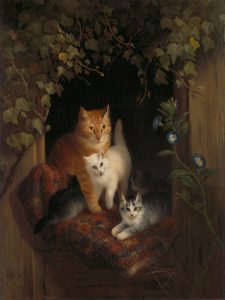12 Rhetoric In The Renaissance!
Darhell Eugene
Summary
The Renaissance is seen as one of the major components of human history- it comes without a doubt that the Renaissance as brought forth a slew of compelling ideas, from the way that we now see art, to the humanist ideas that we follow in order to pursue a specific profession, or any other goal that we have on our minds.
Usually when we think of the Renaissance, we think of the greats such as Leonardo Da Vinci, Michelangelo, Donatello, and other famous figures that are usually touched upon in history class. But there’s a seemingly unknown part of the Renaissance that isn’t talked about; and that is the rise of rhetoric during this time period. In this chapter, we will not only analyze the rise of rhetoric, but also different ideas, meet prominent individuals, and examine how the major changes during the Renaissance, affect the way that we study the time period in today’s age.
Review Question
What individuals come to mind when we think of the Renaissance?
The Birth of Rhetoric and The Renaissance

Europe experienced a strong shift in both intellectual and social changes, starting from the fourteenth through the seventh centuries. This also includes the likes of the arts, which is especially something that was seen throughout the ages, up to today’s society. It’s during this movement, that many assumptions and institutions that were created prior to the Renaissance, were challenged not only in terms of their purpose, but also in their goals, ideologies, and such- like the Catholic church, and the religion of Christianity.
But in this period, rhetoric has achieved much more of an extraordinary position in European education, and in social life, which is great, given that rhetoric seemed to be prominent in the education and culture within Greece, Rome, and Christian Europe societies. As with rhetoric, it grew exceptionally with the rise of the Renaissance- a man named Brian Vickers confirmed the fact that the Renaissance in Europe, is where rhetoric achieved its all-time importance to society in the benefits, influence, as well as the methods that can be done with rhetoric. Renaissance rhetoric was viewed as something that helps with contemplation, and the refinement of one’s morals. It also teaches how one should act in social settings, such as the sprezzatura, which refers to “an easy grace and casual self-confidence.”
Review Question
How did rhetoric play a role in shaping the Renaissance?
Women of The Renaissance

Fortunately, another one of the biggest aspects of the Renaissance was the higher levels of involvement from women, compared to the periods prior to this one- a gigantic plus in of itself. In the Renaissance, women had more access to education and social mobility. One of the subjects that they studied was rhetoric. One of the famous female figures during the Renaissance, Katharina Wilson, mentioned that when it comes to education access for women during the Renaissance, it came to women who were born into a high position in the social ladder. On the other hand, women who were born into a lower position, lacked opportunities- though neither of the two groups couldn’t really pursue learning and scholarship. In other words, education didn’t give women an opportunity to rise above their social standing compared to men during the Renaissance.
Despite this, some women became popular through public speaking. Joanna Vaz, for instance, was prominent for her public oratory skills, and eloquence. She was able to read and write Greek, Latin and Hebrew, was appointed the tutor for the King and Queen of Portugal’s daughter and dabbled a bit with the Lisbon court. Other prominent female figures include Louise Labe, Laura Cereta, Madeleine des Roches, and more.
Christine De Pisan, a daughter of Thomas de Pisan, was one of the first European women writers. As a self-educated writer, Christine spent a great deal of her time reading and writing, even including rhetoric along the way. She was one of the few female writers of the Renaissance who managed to foster a prosperous audience and used rhetoric as a way to advocate for what she preached, including urging women to become something more than themselves; to achieve something with their lives in other words.
Review Question
List at least one of the women of the Renaissance and describe the actions that they did.
The Italian Humanists

Considering the prevalence of rhetoric from the start of the Renaissance (as well as the steadfast interest in it during this period), it has also indirectly caused the rise of commercialism in Italian culture, including the development of a certain group of writers known as the Humanists. Also known as the umanista, The Italian Humanists were an unstoppable force in a sense; from causing the renewed interest in classic languages and rhetoric during the Renaissance, to developing the curriculum known as the studia humanitatis (humanistic studies). It primarily focused on rhetoric, poetics, ethics, and politics, which back then, was seen as important to develop a free and active mind. It’s also worth mentioning that these exact studies paved the way to what we refer to as, the liberal arts (colleges and all). You could say that the Italian Humanists are similar to professors who teach Psychology, English, Music, and other majors affiliated with liberal arts.
The Humanists also had a set of intellectual values. They not only placed a high value on getting the texts completely right, but they also focused on establishing the real value of words and phrases, and an emphasis on concrete facts. They were also responsible for a renewed interest in the study of history within the academic setting. In other words, examining history with a closer look. The Humanists (like Pico) also studied emotions and will, and with this came a new sub-discipline of rhetoric rooted in psychology, known as pathologia.
Review Question #4
In what ways did the Italian Humanists influence the Renaissance?
Petrarch & The Magnificent Italian Humanists In…
The Renaissance itself isn’t a movement after all without some of its most prominent theorists and writers, who are considered to be the ones that also influenced the Renaissance socially. One of the earliest Italian Humanists writers- who is usually associated with the origin of the Renaissance- is Francesco Petrarca, known famously as Petrarch, and he is coined as a prevalent, instrumental writer of his generation. It’s worth mentioning too that he received his education thanks to a notary from Prato.
Petrarch swooned many with his intellectual influence. But he was more interested in rhetoric’s rather powerful (and versatile) persuasive power, rather than how rhetoric can be used for not only harmony, but also for the beauty of language. However, Petrarch and other Italian Humanists (like Coluccio Salutati), thought that rhetoric, when used heavily in the persuasive realm, could possibly be restricted within Christian wisdom. Essentially, Petrarch believed that speech in of itself, doesn’t have an ounce of dignity or genuineness, unless the soul of the respective speaker has dignity. He looked up to Cicero, and it was believed that Cicero’s rhetoric was the very thing that can make Italy as great as Rome in terms of education, and rhetoric.
Review Question
How did Petrarch see or approach rhetoric during this time period?
Conclusion

The Renaissance is a major aspect of human history for a multitude of reasons. Its where not only art experienced a major shift in meaning and techniques, but also for rhetoric, which experienced a shift in terms of the intention, purpose, as well as techniques to learn about rhetoric. The rise of rhetoric also brought forth a slew of newfound concepts, ideas, as well as things that translate over to today’s society, such as the creation of the liberal arts.
How the Renaissance necessitated social change, in a sense of how we now study the time period, was in a sense of how women has progressed in terms of social status and recognition during that time, despite the various amounts of restrictions imposed, compared to the men. We see that the Renaissance developed the liberal arts, and it’s here where we use the collection of subjects within to not only examine society, but to also explore the meaning of art, humanities, and other closely related subjects. From looking in today’s age with a familiar set of lenses (or new ones), the Renaissance had a firm grasp on how we understand rhetoric. With that, we’re able to take various theories and ideas, and apply them to today’s current climate with a twist, thus providing a new perspective on numerous concepts, as well as topics that we are able to approach.
Discussion Questions
- Would you say that you lean more towards how Petrarch sees/approaches rhetoric, or to another influential figure in the previous chapters? Explain your reasoning.
- In what ways did the Renaissance have an effect on human society, including today?
- Taking into account of the chapter readings up to now, which city or era would you rather live in?
Easy grace and casual self-confidence. When someone possesses this characteristic, they are often more easily believed because their effort to persuade is disguised. Contrast sprezzatura (studied carelessness) with arete (virtuous effectiveness).
